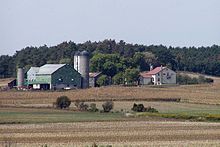
In the 16th century Samuel de Champlain and Gabriel Sagard recorded that the Iroquois and Huron cultivated the soil for maize or "Indian corn".[1] Maize (Zea mays), beans (phaseolus), squash (Cucurbita) and the sunflower (Helianthus annus) were grown throughout agricultural lands in North America by the 16th century. As early as 2300 BC evidence of squash was introduced to the northeastern woodlands region. Archaeological findings from 500 AD have shown corn cultivation in southern Ontario.[2]
Eastern Canada was settled well before the West. Immigration and trading posts came later to Rupert's Land and the Northwest Territories. The early immigrants combined European agricultural and domestication procedures with the indigenous knowledge of the land and animals of the area.
As early as 1605, the French Acadians built dikes in the Maritimes for wheat, flax, vegetables, pasturage and marshland farming.[3] Dairy production is the main contribution of New Brunswick, Nova Scotia, and Prince Edward Island, along with livestock and mixed farming ventures. A small percentage of land is put into use in fruit farming as well along Nova Scotia's northwest coastal areas. The American Revolution, 1775–1783, and its attendant food decline resulted in 3100 hectares cleared in Newfoundland. In the early 19th century Irish immigrants began arriving who cultivated the land in Newfoundland.[4] A very small percentage of the land is suitable in Newfoundland and Labrador for horticultural or crop production because there is a lot of forested and tundra geography. The province has some dairy production and farming concerns. Following World War II, farm training was available at the Government Demonstration Farm. Bonuses were paid for such things as the purchase of pure-bred sires, land clearing, and agriculture exhibition assistance to name a few. The industry of fish processing for food is the largest agricultural contribution from Newfoundland. Newfoundland fisheries, supply cod for the most part, followed closely by herring, haddock, lobster, rose fish, seals, and whales. The fishing industry depends very heavily upon exports and world conditions.[5]

Agriculture in the West started with Peter Pond gardening plots at Lake Athabasca in 1778. Although large-scale agriculture was still many years off, Hudson's Bay Company traders, gold rush miners, and missionaries cultivated crops, gardens and raised livestock.[3] The Northwest Territories, Yukon, and Nunavut are covered with the Canadian Shield, and rocky outcrops, sub Arctic forest soils, and stony phases make up most of the geography. It is an area of comparatively smaller population and not commercially exploited for the most part. Whaling, prawns, and trapping food processing contribute to agricultural food production here.[6]
In New France hops, hemp and livestock were introduced in 1663. The seigneurial system of farming was adopted in Quebec.[7] Quebec's agricultural sector relies heavily on its fruit and vegetable production. In 1890, a competition began to encourage farmers to improve their farms to achieve the Agricultural Merit Order. County farm improvement contests were begun about 1930 involving over 5,000 farms and their evolution over five years. They have some interests in livestock and mixed farming and dairy as well. From 1947, an artificial insemination and breeding centre has been operating in Saint-Hyacinthe, Quebec for breeders clubs.[8][9]
- ^ Bélanger, Claude (2004). "Indian agriculture – Indians of Canada and Quebec". Marianopolis College.
- ^ Dickason, Olive Patricia (1997). Canada's First Nations A History of Founding Peoples from Earliest Times (second ed.). Toronto: Oxford University Press. pp. 20–22. ISBN 978-0-19-541358-8.
- ^ a b Dick, Lyle; Taylor, Jeff (2008). "Agriculture, History of". The Canadian Encyclopaedia. Historica Foundation of Canada. Retrieved 28 January 2008.
- ^ Dick, Lyle; Taylor, Jeff (2008). "Agriculture, History of: Newfoundland". The Canadian Encyclopaedia. Historica Foundation of Canada. Archived from the original on 7 June 2011. Retrieved 28 January 2008.
- ^ Cadigan, Sean (1998). "Agriculture: Newfoundland and Labrador Heritage". Archived from the original on 16 April 2007. Retrieved 10 April 2007.
- ^ "Northwest Territories Agriculture" (PDF). BC Government. Fisheries and Aquaculture Ministry. Archived from the original (PDF) on 26 September 2007. Retrieved 10 April 2007.
- ^ Dick, Lyle; Taylor, Jeff (2008). "Quebec. Agriculture, History of". The Canadian Encyclopaedia. Historica Foundation of Canada. Archived from the original on 23 May 2011. Retrieved 28 January 2008.
- ^ Cloutier, Edmond, ed. (1951). The Canada Year Book 1951 The Official Statistical Annual of the Resources, History, Institutions, and Social and Economic Conditions of Canada. King's Printer and Controller of Stationery. ISBN 978-0-7715-8268-4.
- ^ "2001 Census of Agriculture – Agriculture in Quebec". Sharp decline in number of farms in Quebec. 2001 Census of Agriculture. 2 December 2003. Archived from the original on 5 March 2007. Retrieved 10 April 2007.